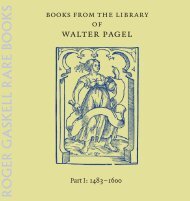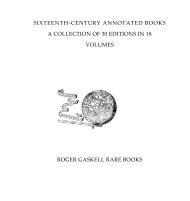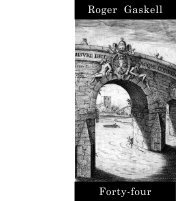pdf - Roger Gaskell Rare Books
pdf - Roger Gaskell Rare Books
pdf - Roger Gaskell Rare Books
Create successful ePaper yourself
Turn your PDF publications into a flip-book with our unique Google optimized e-Paper software.
4to: a4 (–a1) b–c4 B–2B4 c1, 108 of 109 leaves, pp. [22 of 24], 193 (i.e.<br />
191, 185–6 omitted) [3] (errata on last leaf, verso blank). lacking<br />
the imprimatur leaf a1. Titlepages to books II (on M3) and III<br />
(on V4) dated 1663, divisional title ‘Subterraneous experiments, or,<br />
Observations about colemines’ on Z2. Small woodcuts on pp. 13 and<br />
39, full page woodcut on p. 173 and a half page woodcut on p. 175.<br />
1 folding engraved plate (bound as a throwout at the end).<br />
194 x 150mm. Titlepage soiled; light browning and staining in the<br />
upper margins throughout.<br />
Binding: Eighteenthcentury half calf over marbled boards. Rebacked<br />
and corners repaired. Plate soiled and a tear repaired on the verso.<br />
Provenance: Errata corrected in a contemporary hand. An eighteenthcentury<br />
owner, one John Ross, has experimented rather clumsily with<br />
the calligraphy of his name and written some words of shorthand and<br />
a rudimentary diagram on pp. 168–171.<br />
First edition. The imprimatur leaf, lacking in this copy, is dated 5 August<br />
1663. Wing P3099; ESTC R19395.<br />
The Wrst English work on microscopy. The Wrst and largest book is taken<br />
up with the descriptions (but only two rudimentary illustrations) of the<br />
microscopic appearance of plants, insects and anatomical structures. The<br />
second book is on ‘mercurial experiments’ that is experiments with the<br />
vacuum tube, conWrming Boyle’s work and reporting Townley’s experiments;<br />
and the third book is on magnetism. A brief appendix on experiments<br />
conducted in mines is followed by an essay on the new philosophy where<br />
he writes: ‘This is the Age wherein (methinks) Philosophy comes in with a<br />
springtide... I see how all the old Rubbish must be thrown away’ (p. 192).<br />
An early member of the Royal Society (elected in 1661), Power was thus<br />
promoting its programme of experimental reseach, both through his example<br />
and by his rhetoric.<br />
When Hooke’s Micrographia was published in the following year, its<br />
astonishing images diverted attention from Power’s work. Yet Hooke had<br />
been worried that he might have been preempted by Power. He wrote<br />
in the introduction to Micrographia: ‘After I had almost compleated these<br />
Pictures and Observations... I was inform’d that the Ingenious Physitian Dr.<br />
Henry Power had made several Microscopical Observations, which had I not<br />
afterwards, upon our interchangable viewing each other’s Papers, found that<br />
they were for the most part diVering from mine, either in the Subject it self,<br />
or in the particulars taken notice of; and that his design was only to print<br />
Observations without Pictures, I had even then suppressed what I had so far<br />
proceeded in’ (g2v).<br />
‘It was the Wrst book in English on microscopy and the Wrst in any language<br />
to describe (along with Xora and fauna) the nature of various metals as seen<br />
through a microscope. Power’s test of Boyle’s “spring of the air” hypothesis<br />
show that he understood the need for precise instruments and that he<br />
could conduct meticulously controlled experiments. Although his work on<br />
microscopy was shortly eclipsed by that of Hooke and Swammerdam, Power<br />
remains important as one who helped materially to realize the principles and<br />
set the standards of inquiry and exposition formulated by the progenitors







